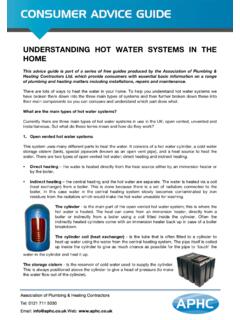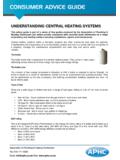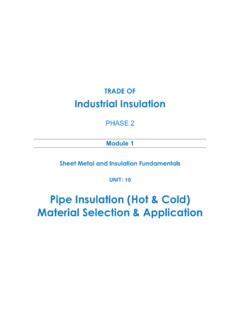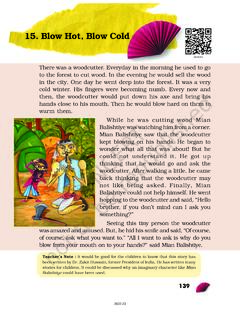Transcription of UNDERSTANDING COLD WATER SYTEMS IN THE HOME …
1 UNDERSTANDING cold WATER SYSTEMS IN THE HOME This advice guide is part of a series of free guides produced by the Association of Plumbing & Heating Contractors Ltd. which provide consumers with essential basic information on a range of plumbing and heating matters including installations, repairs and maintenance. We don t often see the pipework that carries cold WATER around the home, for example, a cold tap on a bath, a cold feed to an electric shower or washing machine or an outside tap for using a garden hose.
2 UNDERSTANDING how cold WATER is distributed around the home will allow you to identify what has gone wrong in the unfortunate event of a leak or ensure you have the most suitable system installed to meet your needs. Getting cold WATER to the home A WATER supplier will provide WATER to a home, through a WATER main, then branch off. At this point, older systems may have one branch that connects up to four homes. New properties will have an installation similar to that shown in the diagram below. It is vital that people living in a property know where and how to turn off the WATER supply to their home, in the event of a leak or for maintenance.
3 cold WATER system components The following materials and components are common to most domestic cold WATER systems. Copper and plastic pipes Pipes for cold WATER systems can be produced in either copper or plastic, and come in many sizes from 8mm to 35mm in diameter. The most common sizes for cold WATER pipes are 15mm and 22mm. Lead pipes Very old cold WATER systems used lead pipes to run WATER around homes; this is still in place in a lot of properties in the UK. Lead pipes are also very commonly used between the WATER company stop tap and the mains stop tap in your home.
4 It is now illegal to fit or alter lead pipe, it must be replaced with a copper or plastic pipe when changes to WATER pipes are required. cold feed This is a pipe which provides cold WATER into a hot WATER or heating system. WATER main This is a pipe that brings cold WATER directly from the WATER pipe in the street to the stop tap in your house Stop tap This can also be called a stopcock or stop valve. This is the tap which turns off the cold WATER into your house, from the WATER coming in from the street.
5 The Storage Cistern This is the reservoir of cold WATER used to supply either the hot WATER cylinder or the central heating system. Inside the cistern there are components: Float operated valve - This is commonly known as a ball valve. It is a mechanical valve that automatically opens and closes as WATER is removed and added to a cistern, and they come in all shapes and sizes and materials. The warning pipe - This is commonly referred to as the overflow.
6 It will advise the occupier that a cistern is full and the valve is not turning off WATER and warning that it could spill over the cistern sides. Types of cold WATER system There are two main types of cold WATER system used in the UK, to distribute WATER around the home. The first (diagram 1 and 2 below), uses WATER supplied directly from the WATER main, called a direct system and the other method (diagram 3 below) uses a storage tank (cistern) to give a store of cold WATER , then distributes the WATER around the home, known as an indirect system.
7 Direct cold WATER supply(with Hot WATER Cylinder)BathBasinWCHot WATER CylinderWashing MachineKitchen SinkStop TapCold MainDirect cold WATER supply(with Combination Boiler)BathBasinWCCombination BoilerWashing MachineKitchen SinkStop TapCold MainDiagram 1 Diagram 2 Indirect cold WATER supplyBathBasinWCHot WATER CylinderWashing MachineKitchen SinkStop TapCold MainDiagram 3 Each type of cold WATER system has advantages and disadvantages to consider. An APHC plumber will be able to help you choose the right system to meet your needs.
8 In summary cold WATER systems provide WATER to and around the home and are relatively straightforward with the majority of new homes having a direct cold WATER system. It is important to understand the cold WATER system within the home in order to isolate the WATER if a leak occurs. About APHC APHC is the trade body for the plumbing and heating industry in England and Wales. APHC members are qualified and professional businesses who are committed to high standards of workmanship and high levels of customer service.
9 Only those plumbing and heating businesses that have passed our quality assurance criteria are accepted as members, giving you the consumer peace of mind. Find A Quality Plumber Visit to find a qualified and reliable plumbing and heating contractor local to you. Alternatively contact the Association of Plumbing & Heating Contractors Ltd using the contact details located at the footer of this page. Like us on Facebook and keep up-to-date with consumer related plumbing and heating news.
10 Please note that this information is meant as a starting point only. Whilst all reasonable efforts have been made, APHC Ltd. makes no warranties that the information is accurate and up-to-date and will not be responsible for any errors or omissions in the information nor any consequences of any errors or omissions. Disadvantages Advantages Direct cold WATER If cold mains fail there is no emergency backup supply Can be cheaper to install than a storage system Cannot always supply cold WATER even if mains WATER pressure is low No chance of WATER growing harmful bacteria More system noise as WATER is under high pressure Can deal with large demand more easily Indirect cold WATER Can be more expensive to install WATER supplied even if mains stops working Cannot deal easily with large demand Can










